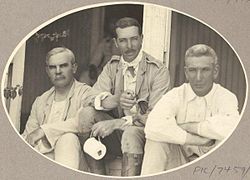| Administrator of the Northern Territory | |
|---|---|
 Badge of the Administrator | |
since 2 February 2023 | |
| Office of the Administrator | |
| Style | His Honour the Honourable |
| Residence | Government House, Darwin, |
| Seat | Darwin |
| Appointer | Governor-General on the advice of the Commonwealth Minister for Regional Development, Local Government and Territories, following consultation with the Northern Territory Chief Minister |
| Term length | At the Governor-General's pleasure (usually 5 years by convention) |
| Formation | 12 June 1931 |
| First holder | John A. Gilruth |
| Website | govhouse |
The administrator of the Northern Territory is an official appointed by the governor-general of Australia to represent the Crown in right of the Northern Territory. [1] [a] They perform functions similar to those of a state governor.
Contents
- Crest of administrator
- South Australia (1863 to 1912)
- Commonwealth of Australia (1912 to present)
- Administrator (1912 to 1919)
- Director (1919 to 1921)
- Administrator (1921 to 1927)
- Government Resident (1927 to 1931)
- Administrator (1931 to present)
- Deputy of the Administrator (1997 to present)
- See also
- Notes
- References
- External links
Strictly speaking, the appointment of an administrator is made by the governor-general acting on the advice of the Australian government, rather than the advice of the government of the Northern Territory. [4] However, ministers have described the process as being based on "advice from the Australian and Northern Territory governments". [5]
Unlike an Australian state governor, the administrator is not the direct representative of the King in the Territory but is instead appointed by the King's federal representative in Australia, the governor-general, to administer the Territory in accordance with the Act. In practice, however, the administrator performs a similar constitutional role to that of a state governor.
The administrator formally appoints the chief minister of the Northern Territory and the members of the Cabinet after every election. In all but a few cases, they are required by convention to act on the Cabinet's advice. The Administrator gives royal assent to all bills passed by the Northern Territory Legislative Assembly. Although the Governor-General (in practice, the Commonwealth Government) has the power to veto any territorial bill, in practice this right is almost never exercised.
The office of the deputy of the administrator was created in 1997.
In 2014, the governor-general granted current, future and living former administrators the title of The Honourable for life, [6] following the lead of Governors-General and Governors of New South Wales in granting the title.[ citation needed ]
The present administrator is Hugh Heggie.
